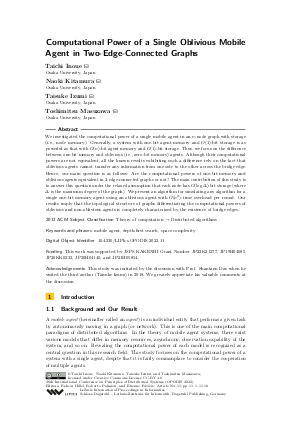Computational Power of a Single Oblivious Mobile Agent in Two-Edge-Connected Graphs
Authors Taichi Inoue, Naoki Kitamura, Taisuke Izumi, Toshimitsu Masuzawa
-
Part of:
Volume:
26th International Conference on Principles of Distributed Systems (OPODIS 2022)
Part of: Series: Leibniz International Proceedings in Informatics (LIPIcs)
Part of: Conference: International Conference on Principles of Distributed Systems (OPODIS) - License:
 Creative Commons Attribution 4.0 International license
Creative Commons Attribution 4.0 International license
- Publication Date: 2023-02-15
File

PDF
LIPIcs.OPODIS.2022.11.pdf
- Filesize: 0.78 MB
- 18 pages
Document Identifiers
Subject Classification
ACM Subject Classification
- Theory of computation → Distributed algorithms
Keywords
- mobile agent
- depth-first search
- space complexity
Metrics
- Access Statistics
-
Total Accesses (updated on a weekly basis)
0Document
0Metadata
Abstract
We investigated the computational power of a single mobile agent in an n-node graph with storage (i.e., node memory). Generally, a system with one-bit agent memory and O(1)-bit storage is as powerful as that with O(n)-bit agent memory and O(1)-bit storage. Thus, we focus on the difference between one-bit memory and oblivious (i.e., zero-bit memory) agents. Although their computational powers are not equivalent, all the known results exhibiting such a difference rely on the fact that oblivious agents cannot transfer any information from one side to the other across the bridge edge. Hence, our main question is as follows: Are the computational powers of one-bit memory and oblivious agents equivalent in 2-edge-connected graphs or not? The main contribution of this study is to answer this question under the relaxed assumption that each node has O(logΔ)-bit storage (where Δ is the maximum degree of the graph). We present an algorithm for simulating any algorithm for a single one-bit memory agent using an oblivious agent with O(n²)-time overhead per round. Our results imply that the topological structure of graphs differentiating the computational powers of oblivious and non-oblivious agents is completely characterized by the existence of bridge edges.
Cite As Get BibTex
Taichi Inoue, Naoki Kitamura, Taisuke Izumi, and Toshimitsu Masuzawa. Computational Power of a Single Oblivious Mobile Agent in Two-Edge-Connected Graphs. In 26th International Conference on Principles of Distributed Systems (OPODIS 2022). Leibniz International Proceedings in Informatics (LIPIcs), Volume 253, pp. 11:1-11:18, Schloss Dagstuhl – Leibniz-Zentrum für Informatik (2023)
https://doi.org/10.4230/LIPIcs.OPODIS.2022.11
BibTex
@InProceedings{inoue_et_al:LIPIcs.OPODIS.2022.11,
author = {Inoue, Taichi and Kitamura, Naoki and Izumi, Taisuke and Masuzawa, Toshimitsu},
title = {{Computational Power of a Single Oblivious Mobile Agent in Two-Edge-Connected Graphs}},
booktitle = {26th International Conference on Principles of Distributed Systems (OPODIS 2022)},
pages = {11:1--11:18},
series = {Leibniz International Proceedings in Informatics (LIPIcs)},
ISBN = {978-3-95977-265-5},
ISSN = {1868-8969},
year = {2023},
volume = {253},
editor = {Hillel, Eshcar and Palmieri, Roberto and Rivi\`{e}re, Etienne},
publisher = {Schloss Dagstuhl -- Leibniz-Zentrum f{\"u}r Informatik},
address = {Dagstuhl, Germany},
URL = {https://drops.dagstuhl.de/entities/document/10.4230/LIPIcs.OPODIS.2022.11},
URN = {urn:nbn:de:0030-drops-176311},
doi = {10.4230/LIPIcs.OPODIS.2022.11},
annote = {Keywords: mobile agent, depth-first search, space complexity}
}
Author Details
Funding
This work was supported by JSPS KAKENHI Grant Number JP22K21277, JP19H04085, JP20KK0232, JP20H04140, and JP21H05854.
Acknowledgements
This study was initiated by the discussion with Prof. Shantanu Das when he visited the third author (Taisuke Izumi) in 2018. We greately appreciate his valuable comments at the discussion.
References
- Reuven Cohen, Pierre Fraigniaud, David Ilcinkas, Amos Korman, and David Peleg. Label-guided graph exploration by a finite automaton. ACM Trans. Algorithms, 4(4):42:1-42:18, 2008. URL: https://doi.org/10.1145/1383369.1383373.
- Ajoy Kumar Datta, Anissa Lamani, Lawrence L. Larmore, and Franck Petit. Enabling ring exploration with myopic oblivious robots. In 2015 IEEE International Parallel and Distributed Processing Symposium Workshop, IPDPS 2015, Hyderabad, India, May 25-29, 2015, pages 490-499. IEEE Computer Society, 2015. URL: https://doi.org/10.1109/IPDPSW.2015.137.
- Yoann Dieudonné, Shlomi Dolev, Franck Petit, and Michael Segal. Explicit communication among stigmergic robots. Int. J. Found. Comput. Sci., 30(2):315-332, 2019. URL: https://doi.org/10.1142/S0129054119500072.
- Yann Disser, Jan Hackfeld, and Max Klimm. Undirected graph exploration with ⊝(log log n) pebbles. In Robert Krauthgamer, editor, Proceedings of the Twenty-Seventh Annual ACM-SIAM Symposium on Discrete Algorithms, SODA 2016, Arlington, VA, USA, January 10-12, 2016, pages 25-39. SIAM, 2016. URL: https://doi.org/10.1137/1.9781611974331.ch3.
- Pierre Fraigniaud, David Ilcinkas, Guy Peer, Andrzej Pelc, and David Peleg. Graph exploration by a finite automaton. Theor. Comput. Sci., 345(2-3):331-344, 2005. URL: https://doi.org/10.1016/j.tcs.2005.07.014.
- Taisuke Izumi, Kazuki Kakizawa, Yuya Kawabata, Naoki Kitamura, and Toshimitsu Masuzawa. Deciding a graph property by a single mobile agent: One-bit memory suffices, 2022. URL: https://doi.org/10.48550/arXiv.2209.01906.
- Sayaka Kamei. Autonomous distributed systems of myopic mobile robots with lights. In ICDCN '21: International Conference on Distributed Computing and Networking, Virtual Event, Nara, Japan, January 5-8, 2021, page 5. ACM, 2021. URL: https://doi.org/10.1145/3427796.3432715.
- Sayaka Kamei, Anissa Lamani, Fukuhito Ooshita, Sébastien Tixeuil, and Koichi Wada. Gathering on rings for myopic asynchronous robots with lights. In Pascal Felber, Roy Friedman, Seth Gilbert, and Avery Miller, editors, 23rd International Conference on Principles of Distributed Systems, OPODIS 2019, December 17-19, 2019, Neuchâtel, Switzerland, volume 153 of LIPIcs, pages 27:1-27:17. Schloss Dagstuhl - Leibniz-Zentrum für Informatik, 2019. URL: https://doi.org/10.4230/LIPIcs.OPODIS.2019.27.
- Fukuhito Ooshita and Sébastien Tixeuil. Ring exploration with myopic luminous robots. Inf. Comput., 285(Part):104702, 2022. URL: https://doi.org/10.1016/j.ic.2021.104702.
- Omer Reingold. Undirected connectivity in log-space. J. ACM, 55(4):17:1-17:24, 2008. URL: https://doi.org/10.1145/1391289.1391291.
- Yuichi Sudo, Daisuke Baba, Junya Nakamura, Fukuhito Ooshita, Hirotsugu Kakugawa, and Toshimitsu Masuzawa. A single agent exploration in unknown undirected graphs with whiteboards. IEICE Trans. Fundam. Electron. Commun. Comput. Sci., 98-A(10):2117-2128, 2015. URL: https://doi.org/10.1587/transfun.E98.A.2117.
